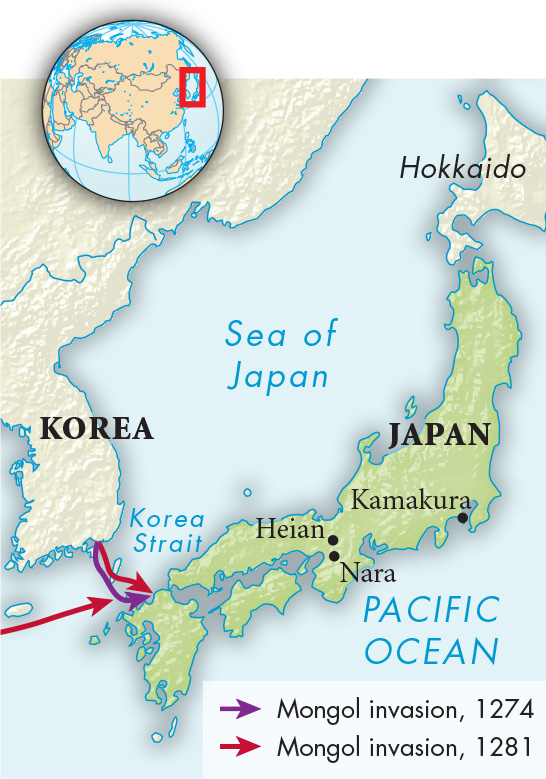Military Rule
The similarities between military rule in Japan and feudalism in medieval Europe during roughly the same period have fascinated scholars, as have the very significant differences. In Europe feudalism emerged out of the fusion of Germanic and Roman social institutions and flowered under the impact of Muslim and Viking invasions. In Japan military rule evolved from a combination of the native warrior tradition and Confucian ethical principles of duty to superiors.
The emergence of the samurai was made possible by the development of private landholding. The government land allotment system, copied from Tang China, began breaking down in the eighth century (much as it did in China). By the ninth century local lords had begun escaping imperial taxes and control by commending (formally giving) their land to tax-exempt entities such as monasteries, the imperial family, and high-ranking officials. The local lord then received his land back as a tenant and paid his protector a small rent. The monastery or privileged individual received a steady income from the land, and the local lord escaped imperial taxes and control. By the end of the thirteenth century most land seems to have been taken off the tax rolls this way. Each plot of land could thus have several people with rights to shares of its produce, ranging from the cultivator, to a local lord, to an estate manager working for him, to a regional strongman, to a noble or temple in the capital. Unlike peasants in medieval Europe, where similar practices of commendation occurred, those working the land in Japan never became serfs. Moreover, Japanese lords rarely lived on the lands they had rights in, unlike English or French lords who lived on their manors.
Samurai resembled European knights in several ways. Both were armed with expensive weapons, and both fought on horseback. Just as the knight was supposed to live according to the chivalric code, so Japanese samurai were expected to live according to Bushido (or “way of the warrior”), a code that stressed military honor, courage, stoic acceptance of hardship, and, above all, loyalty. Physical hardship was accepted as routine, and soft living was despised as weak and unworthy. Disloyalty brought social disgrace, which the samurai could avoid only through seppuku, ritual suicide by slashing his belly.

The Shogun Minamoto Yoritomo in Court Dress This wooden sculpture, 27.8 inches tall, was made about a half century after Yoritomo’s death for use in a shrine dedicated to his memory. The bold shapes convey Yoritomo’s dignity and power. ( Yoritomo [Minamotono-Yoritomo], wood with colored painting and quartz eyes, Kamakura Period, 1300/National Museum, Tokyo, Japan/akg-images)
The Kamakura Shogunate derives its name from Kamakura, a city near modern Tokyo that was the seat of the Minamoto clan. The founder, Yoritomo, ruled the country much the way he ran his own estates, appointing his retainers to newly created offices. To cope with the emergence of hard-to-tax estates, he put military land stewards in charge of seeing to the estates’ proper operation. To bring order to the lawless countryside, he appointed military governors to oversee the military and enforce the law in the provinces. They supervised the conduct of the land stewards in peacetime and commanded the provincial samurai in war.
Yoritomo’s wife, Masako, protected the interests of her own family, the Hōjōs, especially after Yoritomo died. She went so far as to force her first son to abdicate when he showed signs of preferring the family of his wife to the family of his mother. She later helped her brother take power away from her father. Thus the process of reducing power holders to figureheads went one step further in 1219 when the Hōjō family reduced the shogun to a figurehead. The Hōjō family held the reins of power for more than a century until 1333.

Kamakura Shogunate, 1185–1333
The Mongols’ two massive seaborne invasions in 1274 and 1281 (see “Chinggis’s Successors” in Chapter 12) were a huge shock to the shogunate. The Kamakura government was hard-pressed to gather adequate resources for its defense. Temples were squeezed, farmers were taken away from their fields to build walls, and warriors were promised generous rewards in return for their service. Although the Hōjō regents, with the help of a “divine wind” (kamikaze), repelled the Mongols, they were unable to reward their vassals in the traditional way because little booty was found among the wreckage of the Mongol fleets. Discontent grew among the samurai, and by the fourteenth century the entire political system was breaking down. Both the imperial and the shogunate families were fighting among themselves. As land grants were divided, samurai became impoverished and took to plunder and piracy, or shifted their loyalty to local officials who could offer them a better living.
The factional disputes among Japan’s leading families remained explosive until 1331, when the emperor Go-Daigo tried to recapture real power. His attempt sparked an uprising by the great families, local lords, samurai, and even Buddhist monasteries, which had thousands of samurai retainers. Go-Daigo destroyed the Kamakura Shogunate in 1333 but soon lost the loyalty of his followers. By 1338 one of his most important military supporters, Ashikaga Takauji, had turned on him and established the Ashikaga Shogunate, which lasted until 1573. Takauji’s victory was also a victory for the samurai, who took over civil authority throughout Japan.

